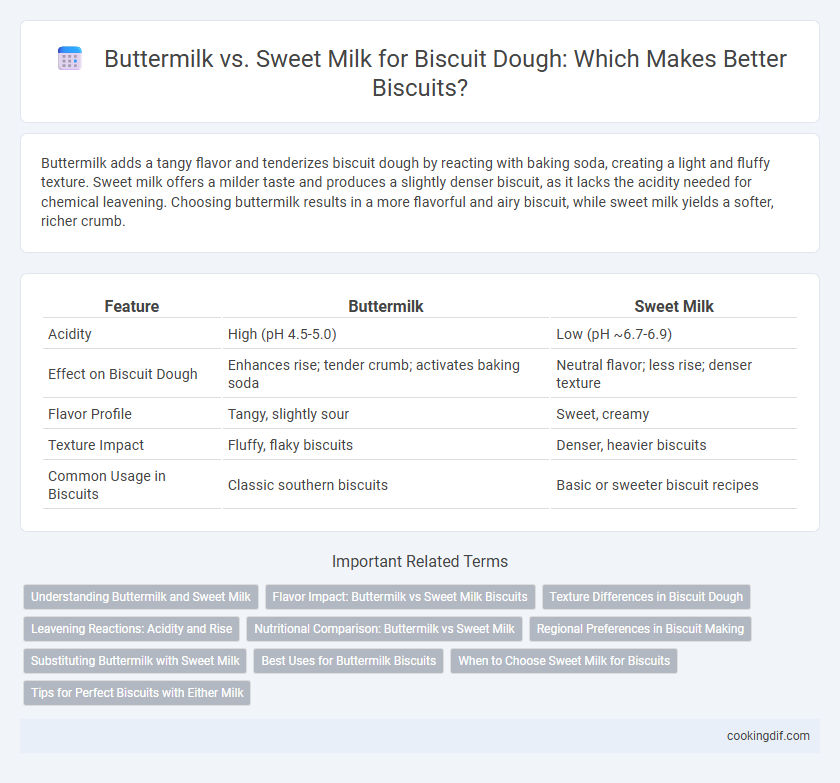Buttermilk adds a tangy flavor and tenderizes biscuit dough by reacting with baking soda, creating a light and fluffy texture. Sweet milk offers a milder taste and produces a slightly denser biscuit, as it lacks the acidity needed for chemical leavening. Choosing buttermilk results in a more flavorful and airy biscuit, while sweet milk yields a softer, richer crumb.
Table of Comparison
| Feature | Buttermilk | Sweet Milk |
|---|---|---|
| Acidity | High (pH 4.5-5.0) | Low (pH ~6.7-6.9) |
| Effect on Biscuit Dough | Enhances rise; tender crumb; activates baking soda | Neutral flavor; less rise; denser texture |
| Flavor Profile | Tangy, slightly sour | Sweet, creamy |
| Texture Impact | Fluffy, flaky biscuits | Denser, heavier biscuits |
| Common Usage in Biscuits | Classic southern biscuits | Basic or sweeter biscuit recipes |
Understanding Buttermilk and Sweet Milk
Buttermilk is a fermented dairy product with a tangy flavor and acidic nature that reacts with baking soda or baking powder to create light, fluffy biscuits with a tender crumb. Sweet milk, also known as regular whole or skim milk, is unfermented and lacks acidity, resulting in biscuits with a milder flavor and denser texture when used in dough. Understanding the chemical differences between buttermilk and sweet milk is essential for achieving the desired rise, texture, and taste in biscuit recipes.
Flavor Impact: Buttermilk vs Sweet Milk Biscuits
Buttermilk imparts a tangy, slightly acidic flavor to biscuit dough, enhancing the depth and complexity of the final product, while sweet milk offers a milder, creamier taste that results in a softer, more neutral biscuit flavor. The acidity in buttermilk also reacts with baking soda, producing lighter, flakier biscuits with a distinct tang that sweet milk cannot replicate. Bakers seeking a traditional, richly flavored biscuit often prefer buttermilk for its unique flavor profile and leavening benefits.
Texture Differences in Biscuit Dough
Buttermilk creates a tender, flaky biscuit texture due to its acidity, which reacts with baking soda to produce carbon dioxide gas, resulting in light, airy layers. Sweet milk, lacking this acidity, yields a denser, softer crumb with less rise and flakiness in the biscuit dough. The choice between buttermilk and sweet milk directly impacts the biscuit's texture, with buttermilk favoring a crisp exterior and pronounced layers.
Leavening Reactions: Acidity and Rise
Buttermilk's higher acidity reacts with baking soda in biscuit dough, producing carbon dioxide that creates a lighter, fluffier rise compared to sweet milk. Sweet milk lacks this acidity, resulting in less leavening power and denser biscuits unless baking powder is used as a leavening agent. The acid-base reaction in buttermilk-based dough enhances tenderness and volume, making it the preferred choice for soft, airy biscuits.
Nutritional Comparison: Buttermilk vs Sweet Milk
Buttermilk contains fewer calories and less fat compared to sweet milk, making it a healthier option for biscuit dough while providing a tangy flavor due to its lactic acid content. Sweet milk has higher sugar and natural lactose levels, which contribute to a slightly sweeter taste and increased carbohydrate content in biscuits. Both buttermilk and sweet milk offer essential nutrients like calcium and vitamin D, but buttermilk's probiotics can aid digestion and improve gut health.
Regional Preferences in Biscuit Making
Buttermilk is the preferred choice for biscuit dough in the Southern United States due to its tangy flavor and acidic properties that react with baking soda, producing tender, flaky biscuits. Sweet milk is more commonly used in Northern regions where a milder taste and softer texture are favored in biscuit recipes. The regional variation in milk choice significantly influences the final biscuit's flavor profile and crumb structure, reflecting local culinary traditions.
Substituting Buttermilk with Sweet Milk
Substituting buttermilk with sweet milk in biscuit dough affects texture and flavor, as buttermilk's acidity reacts with leavening agents to create tender, fluffy biscuits. Using sweet milk requires adding an acid like lemon juice or vinegar to mimic buttermilk's chemical properties and achieve comparable rise and softness. Sweet milk alone results in a denser biscuit with less tang, so balancing acidity is crucial for optimal biscuit dough performance.
Best Uses for Buttermilk Biscuits
Buttermilk is the preferred choice for biscuit dough due to its acidity, which reacts with baking soda to create tender, flaky layers and a richer flavor profile. Its thicker consistency enhances dough texture, resulting in biscuits with a moist crumb and golden crust, ideal for classic Southern-style biscuits. In contrast, sweet milk produces a denser biscuit with less rise, making buttermilk best for achieving light, fluffy, and flavorful biscuits.
When to Choose Sweet Milk for Biscuits
Sweet milk is ideal for biscuit dough when a lighter, more tender texture is desired, as it contains less acidity than buttermilk. This milk option helps achieve a softer crumb and slightly sweeter flavor profile, perfect for breakfast biscuits or those served with sweet toppings. Choosing sweet milk is also beneficial in recipes where the leavening relies solely on baking powder rather than baking soda, ensuring proper rise without the tangy taste of buttermilk.
Tips for Perfect Biscuits with Either Milk
Using buttermilk in biscuit dough creates a tender, tangy crumb due to its acidity reacting with baking soda, while sweet milk offers a milder flavor and softer texture. For perfect biscuits, chill the milk and dough thoroughly before baking to ensure flakiness and rise. Incorporate cold dairy and avoid overmixing to retain air pockets, resulting in light, flaky biscuits regardless of milk choice.
Buttermilk vs Sweet milk for biscuit dough Infographic

 cookingdif.com
cookingdif.com